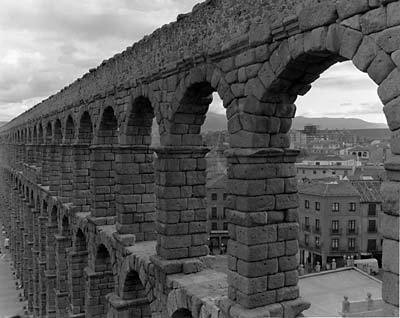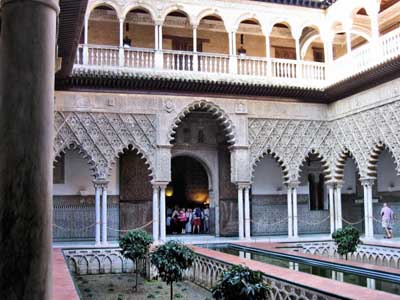Spanish history

Roman aqueduct at Segovia.

The Alcázar in Seville, showing the rich and intricate decorations of the highly skilled Arab craftsmen.
When the Phoenicians, who were an ancient seafaring race, first visited Spain in order to trade, they discovered that the country was overrun with swarms of rabbits. Because of this they called the land "Schephania" which mans literally "land of rabbits."
The earliest inhabitants of Spain left marvelous and vivid paintings on the walls of caves but it was probably later, in about 2500 BC, that the Iberians, who gave their name to the Iberian peninsula (Spain and Portugal), came over from North Africa. Little is known of the history of Spain for the next two thousand years, although at one time Phoenicians and Greeks set up trading posts in the south.
In the 6th century BC two invasions took place, one from the north and one from the south. The Celts came across the Pyrenees and intermarried with the Iberians and settled there. From the south came the Carthaginians of North Africa. They remained in the south-east of Spain until the 3rd century, when they pushed up the east coast and inland under the leadership of Hamilcar. Hamilcar built up a state, a treasury, and an army, and his son Hannibal carried out his work.
At this time Carthage was engaged in a long and bitter struggle with Rome, which ended in the defeat of Carthage. Spain now lay open to the Romans and from the end of the Second Punic War, in 201 BC, Rome started to gain control over the country, at first fighting, then building new cities, improving agriculture, and introducing Roman justice and first civilization.
Vandals and Visigoths
Roman rule brought peace and prosperity to Spain for over 400 years, but in the 5th century AD the Roman Empire was overrun by a number of barbarian tribes from the East. These people, Vandals, Alans, Sueves, first reached Spain in about AD 409. They arrived in waves, ravaging the country and destroying much of the civilizing work of Rome.
The last barbarians to invade Spain were the Visigoths. They eventually conquered the whole country and remained rulers of the Iberian peninsula for nearly 300 years.
In 711 the Mohammedan Arabs and Moors led by Tarik (or Tariq), crossed the Straits of Gibraltar and arrived in Spain. They landed on the rock called "Gebel-el-Tarik" or "Mount Tarik," after their leader from which the name Gibraltar is taken. On July 19, 711, with some 12,000 men, Tarik utterly defeated the Visigoth King Roderic in a battle on the shore of Lake Janda. Roderic was killed during the battle and Tarik advanced victoriously as far as Toledo.
Arab rule
The Arabs brought with them a new and highly developed civilization. Islam was immediately established, and at first the country was subject to the rule of the Caliph at Damascus. But the Mohammedan empire became so large that it was eventually divided up, and in AD 758 a Caliph was set up in Spain with a capital at Cordova. This town grew into a magnificent city, with half a million inhabitants and superb buildings, including 400 mosques and 900 baths.
Although the Arabs were a warlike race, and could at times show cruelty, they ruled Spain wisely and did not force the people to become Mohammedans. Indeed, they even discouraged it at times because only non-Mohammedans were liable to be taxed. Under their rule Spain became very prosperous. The cultivation of oranges, rice, sugar, and cotton was introduced into the country, as was the art of pottery and the manufacture of silk. The Arabs were also craftsmen and made exquisite ornaments.
The 'Reconquista'
It too the Arabs seven years to conquest the whole of Spain, after which hey ruled for 500 years. On the death of the famous Caliph Almanzor in 1002 the Arab Caliphate in Spain began to decline. In 1031 it was abolished and in its place there grew up a number of small independent Moslem states called Taifas kingdoms. A number of small Christian kingdoms had already been established in the north of Spain; the most important of these were Leon, Castile, Navarre, and Aragon. With the decline of the Caliphate these grew larger and soon they became ambitious to conquer the whole country.
The first step in the direction came in 1085 when Alfonso VI of Castile conquered the Arab state of Toledo. This was the era of the Crusades, and it was not only to the Holy Land that Christian soldiers marched to war. Many Crusaders came and fought the Mohammedans in Spain. A series of defeats were inflicted on them, until by 1267 all Spain was under Christian rule except for the kingdom of Granada.
This period of Spanish history, known as the Reconquista, was full of heroism and romance. The most famous hero of the time was a Castilian nobleman called Rodrigo Diaz de Vivar, or "the Cid." His feats of daring and chivalry have been told by the poets and story-tellers of that time, and also in later literature.
A great European power
In 1469 one of the most important events in Spanish history took place: Isabella, Queen of Castile, married Ferdinand of Aragon. As a result the two kingdoms were united when Ferdinand came to the throne of Aragon in 1479. In 1492 Grenada was defeated and the whole of Spain was united under Ferdinand and Isabella. Queen Isabella was a more powerful character than her husband, and she did much for Spain: law and order were established everywhere and trade was encouraged. It was Isabella, too, who provided Columbus with the means to make his historic voyage. Unfortunately she also did harm: she was fanatically religious and determined to rid Spain not only of all Islamists but also of all Jews and of all Christians outside the Roman Catholic Church. It was she who instigated the setting up of the Spanish Inquisition which committed many cruel acts in the name of Christ.
Meanwhile the Spanish dominions were growing larger and larger. Following the discoveries of Columbus a large empire was won in America: Mexico was conquered by Cortes, and Peru by Pizarro. Later, Venezuela and Florida were also acquired. In Europe, too, there were some considerable gains. In 1496 the Spanish princess Joanna married Philip of Flanders; in 1516 their son Charles V at the age of sixteen became heir to the world's largest dominions. He was to rule Spain, the Netherlands, Luxemburg, and Austria.
In his last years Charles abdicated and retired to a monastery; the German empire then passed to his brother Ferdinand, while Charles' son Philip II inherited Spain, the Netherlands, part of Italy, and the American colonies. He was also for a time King Regent of England, having married the unfortunate English Queen Mary.
Decline
It was under Philip II that the decline of Spain began. Philip was a melancholy man with a single aim: to stamp out the Protestant religion in Europe. For many years he tried unsuccessfully to destroy the Protestants in Holland. Next he dispatched the Great Armada (see Spanish Armada) to England in 1588. Despite defeat, the Spaniards continued to fight in France, the Mediterranean, and the Netherlands, until 1609 Spain was forced to recognize the independence of the Dutch.
The end of Philip's reign saw the golden age of art and literature. Meanwhile the court lived with great magnificence, spending huge sums on pleasure, which were paid for out of the taxes. The Moors and the Jews had been expelled from Spain for heresy and this had a disastrous effect on trade and agriculture. The great wars which had won Spain such glory had also cost her dear in money and human lives. Spain swiftly declined in power from this time on.
At he beginning of the 18th century the line of Charles V became extinct and Louis XIV of France wanted his grandson to become King of Spain. The Spanish finally agreed but the rest of Europe was alarmed at the possibility of France and Spain being joined together. There ensued a long war known as the War of the Spanish Succession, as a result of which, in 1713, it was decided that the French prince should remain King of Spain, but should never become King of France.
In the following century the French Emperor imposed his brother Joseph on the Spanish as their King. But this was too much for Spanish pride: they rose in revolt and, with British help, managed eventually to drive him from their country.
Franco
The Spanish monarchy lasted until 1931 when a Republic was established. However, this lasted only five years. A revolution broke out in Spanish Morocco and quickly spread throughout Spain. The principal leader of the rebels was General Francisco Franco. A bitter and ruinous civil war developed which was to last for three years. At the end of three years the supporters of General Franco, known as the Nationalists, were victorious.
In 1947 the Law of Succession made Spain a monarchy without a king, awaiting the restoration of the throne in the post-Franco era. In 1967 granted some independence to the Cortes (legislature) and permitted heads of families to vote for some of its delegates. This, along with a relaxation of censorship, softened the growing opposition to the regime among students, labor unions, and regional separists. In 1969 Prince Juan Carlos was named the heir apparent to the Spanish throne. Franco died in 1975 and was duly succeeded by Juan Carlos.
Emergence of modern Spanish democracy
With the new prime minister, Adolfo Suarez, the kind worked to liberalize the Franco inheritance. Political parties were legalized; the Cortes was transformed into a bicameral legislature and the first elections since 1936 were held.
Under the new monarchy, Spain became a full participant in European affairs. It joined the Council of Europe in 1977, NATO in 1982, and the EU in 1986.
